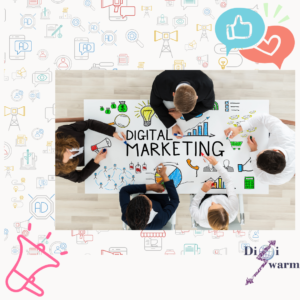1. Setting Clear Goals and Objectives
Defining Your Purpose
Start by clearly defining what you want to achieve in the title best digital marketing agency efforts. Goals should be Specific, Measurable, Achievable, Relevant, and Time-bound (SMART). Whether it’s increasing brand awareness, generating leads, or boosting sales, having clear objectives guides your strategy and helps measure success.
Aligning with Business Objectives
Ensure your digital marketing goals align with your overall business objectives. This alignment ensures consistency in your messaging and helps prioritize marketing efforts that contribute to the business’s growth.
2. Understanding Your Audience

Creating Buyer Personas
Develop detailed buyer personas to represent your ideal customers. Consider factors like demographics, behavior patterns, motivations, and challenges. Understanding your audience allows you to tailor your marketing messages to their needs and preferences.
Conducting Market Research
Utilize market research tools and techniques to gather insights about your target audience. Analyze data to understand trends, preferences, and pain points, enabling you to create content that resonates with your audience.
3. Building a Strong Brand Presence

Establishing Brand Identity
A strong brand identity sets you apart from competitors. Ensure consistency in your brand’s visual elements, tone, and messaging across all digital platforms. This consistency builds trust and recognition among your audience.
Crafting a Unique Value Proposition
Your value proposition should clearly communicate what makes your brand unique and why customers should choose you over competitors. It should be integrated into all marketing communications to reinforce your brand’s distinct advantages.
4. Utilizing Search Engine Optimization (SEO)

Optimizing On-Page Elements
Ensure your website’s on-page elements, such as meta tags, headers, and content, are optimized for relevant keywords. This optimization improves your site’s visibility in search engine results, driving organic traffic.
Building Quality Backlinks
Backlinks from authoritative sites enhance your website’s credibility and improve search engine rankings. Focus on acquiring high-quality backlinks through guest blogging, collaborations, and content partnerships.
5. Creating Engaging Content
Developing a Content Strategy
Create a comprehensive content strategy that outlines what type of content you’ll create, for whom, and how often. Use a mix of formats like blog posts, videos, infographics, and podcasts to keep your audience engaged.
Ensuring Content Relevance and Value
Produce content that addresses your audience’s pain points, answers their questions, and provides value. High-quality, relevant content establishes your authority in your industry and encourages audience interaction.
6. Leveraging Social Media Platforms

Choosing the Right Platforms
Identify which social media platforms your target audience uses most and focus your efforts there. Each platform has unique characteristics, so tailor your content to suit the preferences of each audience.
Building Community Engagement
Engage with your audience by responding to comments, participating in discussions, and sharing user-generated content. Building a sense of community fosters loyalty and encourages brand advocacy.
7. Implementing Paid Advertising
Utilizing Pay-Per-Click (PPC) Campaigns
PPC campaigns, such as Google Ads, allow you to target specific keywords and demographics. Effective PPC campaigns drive traffic and conversions, providing a measurable return on investment.
Exploring Social Media Advertising
Social media platforms offer targeted advertising options that reach specific audience segments. Use social media ads to boost brand awareness, promote products, and generate leads.
8. Engaging in Email Marketing

Building a Subscriber List
Create and nurture an email list by offering value-driven incentives for sign-ups, such as exclusive content or discounts. A well-segmented email list ensures your messages reach the right audience.
Crafting Personalized Campaigns
Personalization enhances email marketing effectiveness. Tailor your messages based on subscriber preferences, behavior, and purchase history to improve engagement and conversion rates.
9. Analyzing and Measuring Results
Utilizing Analytics Tools
Use analytics tools to track the performance of your digital marketing efforts. Key metrics include website traffic, conversion rates, click-through rates, and customer engagement.
Adjusting Strategies Based on Data
Regularly review analytics data to assess what’s working and what’s not. Use insights to refine your strategies, optimize campaigns, and make informed decisions that enhance overall performance.
10. Staying Updated with Trends and Technology
Keeping Abreast of Industry Changes
Digital marketing is constantly evolving. Stay updated with the latest trends, technologies, and best practices by following industry blogs, attending webinars, and participating in online communities.
Adapting to New Platforms and Tools
Embrace new digital platforms and tools that can enhance your marketing efforts. Being adaptable and open to innovation keeps your strategy relevant and competitive.
Conclusion
A successful digital marketing strategy combines clear goals, audience understanding, a strong brand presence, SEO, engaging content, social media, paid advertising, email marketing, data analysis, and adaptability to trends. By integrating these components, businesses can effectively reach their target audience, build lasting relationships, and achieve sustained growth in the digital age.
